Oxalis — a genus in a hurry
Wiida Basson
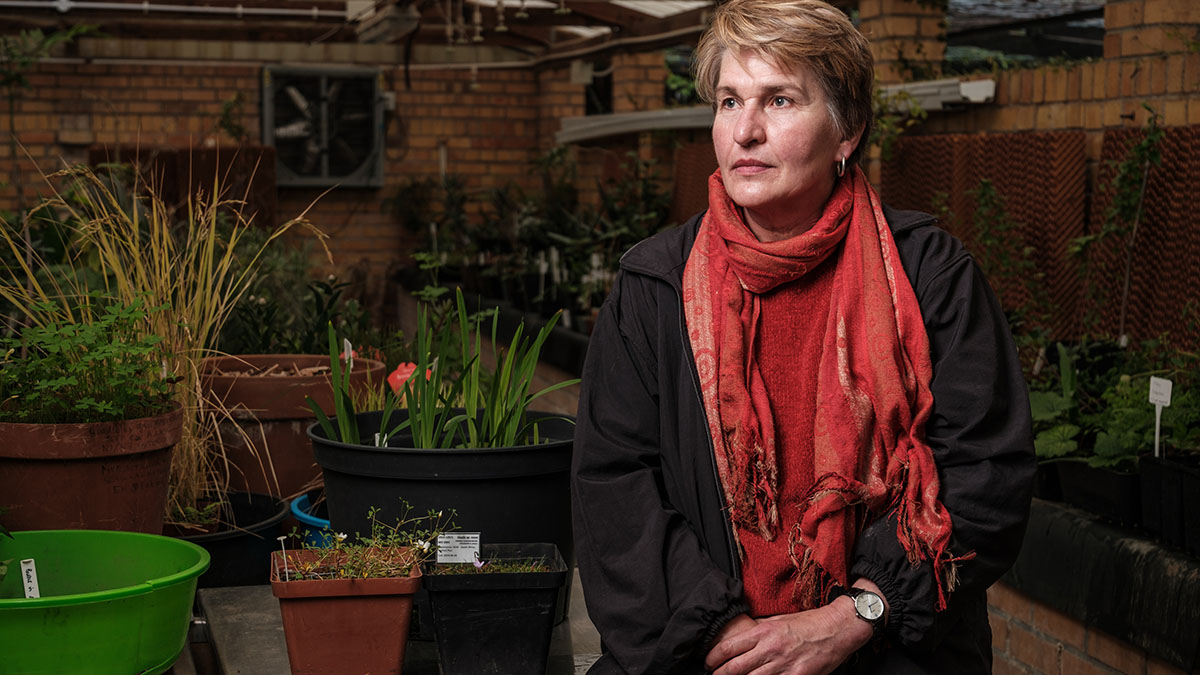
Prof Léanne Dreyer, a leading expert on Southern African Oxalis in the Department of Botany and Zoology at SU | Photo by Stefan Els
The Western Cape is renowned for being host to the most diverse geophyte flora in the world, including roughly 2 100 species from 20 families. The factors driving this remarkable diversity, however, are still poorly understood.
Among these flowering bulbs are species of the Southern African Oxalis genus. They may seem like some of the most fragile, puny little plants out there, but in terms of adaptation, they are punching way above their weight.
As a matter of fact, the many strategies that the humble wood sorrel has developed over the past 20 to 35 million years to survive the extreme environments and droughts of Southern Africa still leave botanists dumbfounded.
One such botanist is Prof Léanne Dreyer, a leading expert on Southern African Oxalis in the Department of Botany and Zoology at Stellenbosch University (SU).
She has been studying this genus since the late 1980s, when she worked as a postgraduate student in the herbarium of the South African National Biodiversity Institute (SANBI) in Pretoria.
“One of my duties as scientific officer was plant identification, and it just so happened that Oxalis landed on my desk.
“The pile of unidentified specimens was way higher than that of the known species, and it also quickly became clear that the taxonomy of the known species needed urgent revision,” she says.
The last such revision of the genus was done in 1944 by Terence Macleane Salter (1881–1969), an English-born South African amateur botanist and collector with strong ties to the Bolus Herbarium in Cape Town.
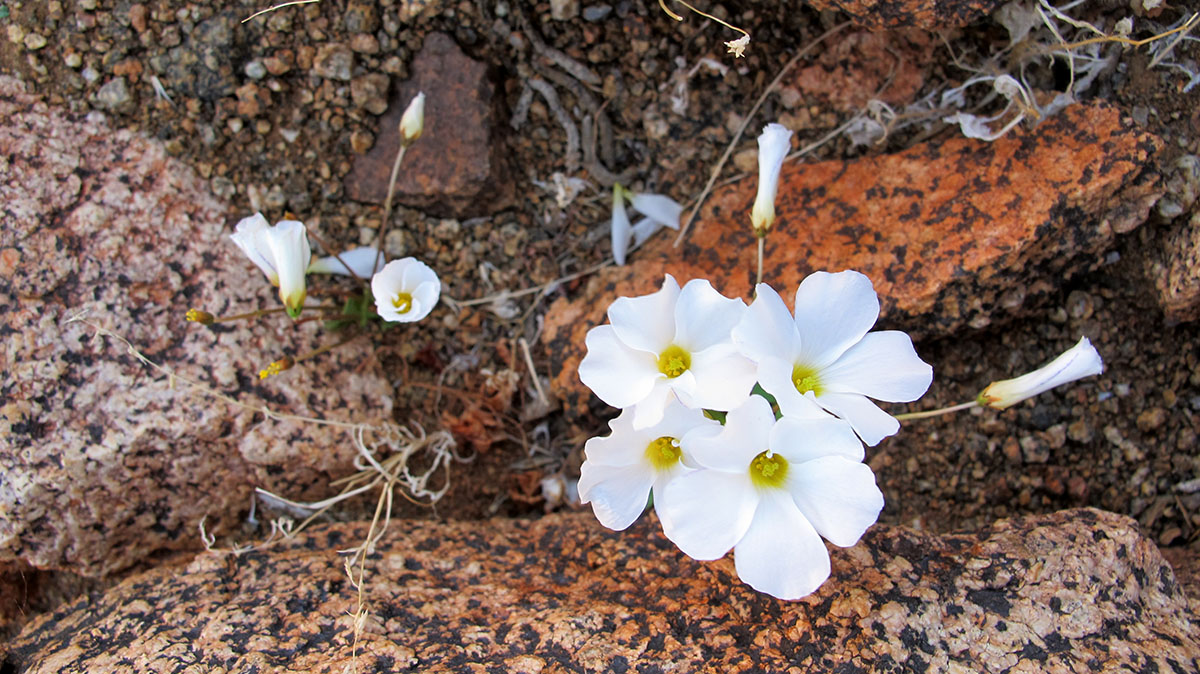
Oxalis dreyerae was named after Prof Léanne Dreyer in acknowledgement of her significant contribution to the study of the genus Oxalis.︱Photo by Francois Roets
Leaving a legacy
In her corner office in the Natural Sciences Building, Dreyer has her latest pet project on display: photographic plates documenting the germination of several rare species of Oxalis on a daily basis.
She obtains the seeds from the Oxalis research collection in the SU Botanical Garden — the largest collection of Southern African Oxalis in the world, compiled over the past 25 years.
As soon as the seedlings have sprouted, Dreyer pots and returns them to the botanical garden. At the end of the rainy season, she plans to unearth the little plants, wax-embed and section them so she can document the divergent patterns of first bulb formation displayed by different groups of related species.
Dreyer is literally surrounded by more than 30 years of research on this genus. On the floor to her left lies a pile of micrographs of pollen grains from 210 Oxalis species, dating back to her PhD thesis, completed in 1986. On the right, under the large window, a collection of microscopic-sized seeds is laid out in petri dishes for the germination project.
Behind Dreyer are piles of pressed Oxalis specimens, ready to be mounted and filed as part of her ever-growing herbarium collection. Moreover, behind a large bookshelf is a table with microscopes and plant material scattered over its surface. This is where the seedlings are meticulously studied and compared.
Another project Dreyer recently embarked on is the writing of an Oxalis field guide in collaboration with one of her first doctoral students, Dr Kenneth Oberlander. The curator of the SU Botanical Garden, Dr Donovan Kirkwood, is providing photographic input.
“We are finally putting everything we know about Oxalis into a field guide that the general public will be able to use and understand,” she says. "It will include a general introduction to the biology of the genus, followed by short descriptions, including the diagnostic traits and distribution areas, of more than 200 species. A detailed photographic plate will accompany each species description.”
Visual representation of the inverse germination process | Animation by Cayla Basson
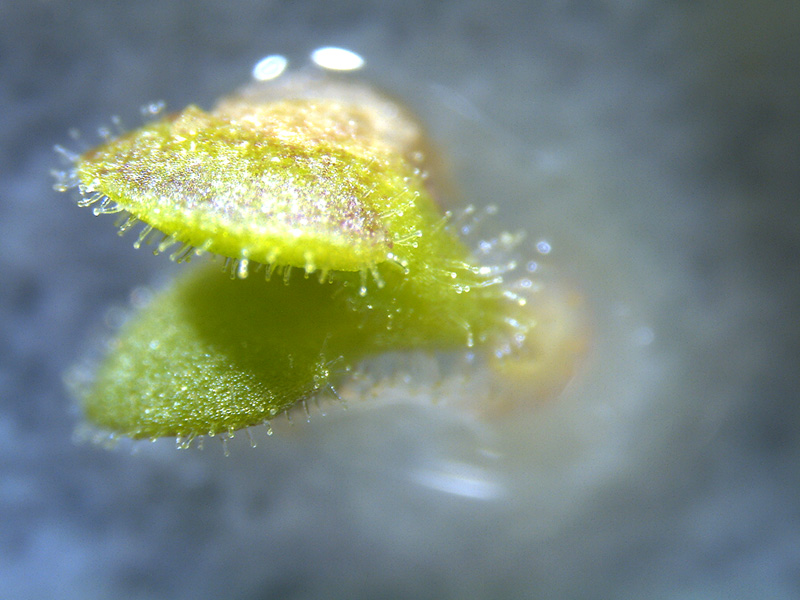
On its first day of germination, Oxalis deserticola starts unfurling its seed leaves. | Photo by Prof Léanne Dreyer
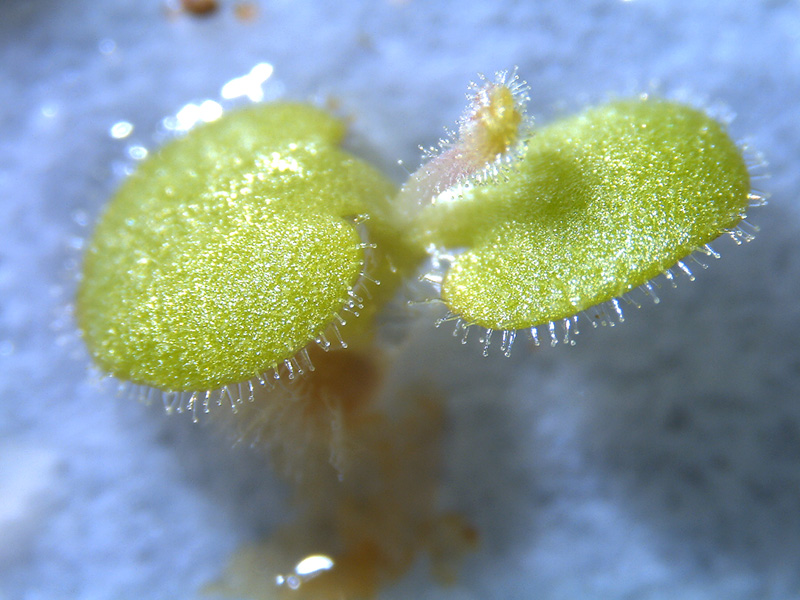
At the end of day two, the seed leaves have unfolded completely and a short stem starts to form. | Photo by Prof Léanne Dreyer
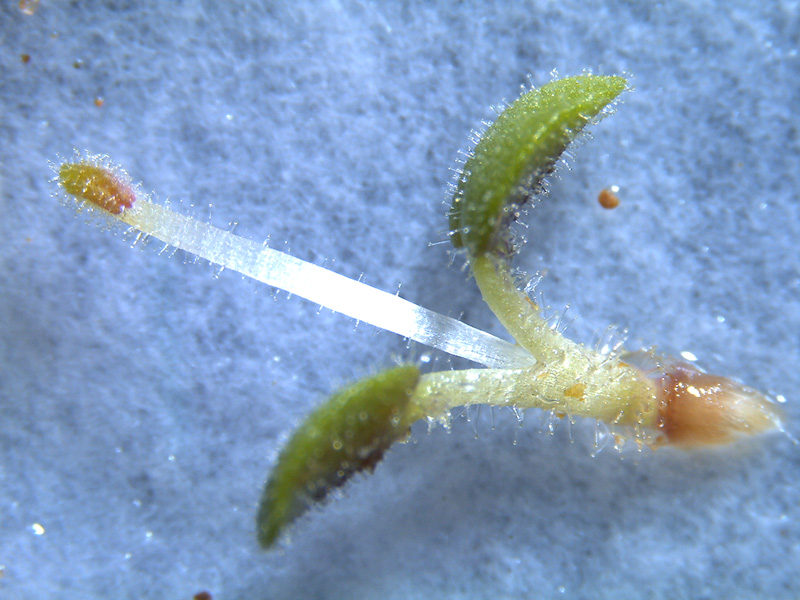
By day three, the seedling is ready to be potted. | Photo by Prof Léanne Dreyer
An evolutionary predisposition for clinging to life
When learning about Oxalis’ extraordinary feats of germination, one cannot help but admire the little plant’s zest for life.
The first mind-boggling fact about Oxalis is that the Southern African species changed their growth form. Dreyer explains: “In the ancestral centre of Oxalis diversity in South-Central America, most species are either annual or form woody above-ground plant bodies. A few have subterranean tubers, and one species forms bulb-like structures out of the bases of their leafstalks. All Southern African Oxalis species, however, form true bulbs — a trait unique to all native species.
“This is the weirdest thing to have happened. We think Oxalis was pre-adapted to be drought tolerant and to survive in extreme environments.
“When it arrived in the Western Cape with its Mediterranean climate, it was already able to withstand long hot summers and then made the best of the predictable onset of the winter rainfall season.”
But going underground to survive the heat during the Western Cape’s dry summer months is only the first trick in this tough little plant’s arsenal of survival strategies.
Almost two-thirds of Southern African Oxalis species produce seeds that are recalcitrant, meaning they cannot tolerate desiccation (full moisture loss) and must germinate immediately after being shed. But even more unique in the case of many of these species is the incidence of reverse germination, a process in which the seed leaves and the first foliar leaf unfurl within the first 24 to 48 hours after shedding, without any elongation or support from an embryonic root (called a "radicle").
Biologically speaking, this kind of behaviour is unprecedented, says Dreyer.
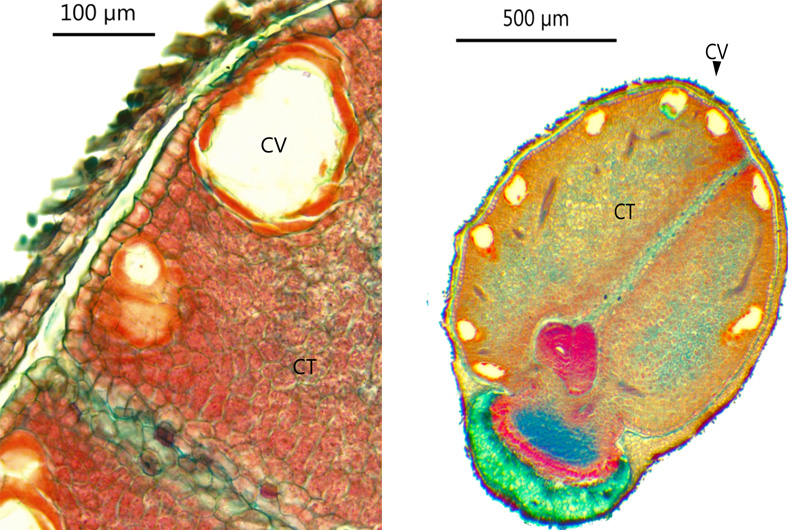
On the right is a microscopic image of the longitudinal sections of a recalcitrant Oxalis seed with multiple unusual cavities in the seed leaves (CT). On the left is a close-up view of one such cavity, in which the endophytic bacteria are believed to reside. | Images by Michelle Jooste

Cross-sections of photosynthetic leaves containing large oxalate crystals (CR), first published in BMC Plant Biology (2019)︱Image by Michelle Jooste
In the process of trying to understand this extraordinary feat of germination, Dreyer and one of her postgraduate students, Michelle Jooste, found evidence of an assemblage of endophytic bacteria in the vegetative and reproductive organs of these Oxalis species. (Plants generally use this type of bacteria to boost growth under normal and challenging conditions.)
“During germination, the bacteria inhabit the mucilage secreted at the base of recalcitrant Oxalis seedlings. The mucilage is a thick, gluey substance formed through the breakdown of a collar of cells at the base of the stem portion below the seed leaves.
“As the cells disintegrate, they release both sugars and hydrophilic substances around the base of the seedling. These hydrophilic substances attract water, thus building the mucilage, while the sugars provide a source of nutrition to the endophytic bacteria released into the mucilage,” Dreyer explains.
These bacteria are hosted within the plant body, quite possibly in specialised structural cavities, where they feed on oxalate — an organic acid produced by plants as a byproduct of photosynthesis. Nine of the most abundant species of endophytic bacteria identified in Oxalis seeds and seedlings thus far belong to the genus Bacillus.
Dreyer explains the significance of this discovery: “Bacillus species are capable of fixing atmospheric nitrogen (and providing it to the seedling to grow), which helps explain how these seedlings can grow without roots. In turn, the bacteria thrive on oxalates as their only and often preferred source of carbon”.
Luckily, Oxalis is so rich in oxalates that the genus name is derived from their abundant presence.
“We think this unusual relationship must have evolved over millions of years, helping Oxalis make the most of a very predictable winter rainfall season by giving it just enough time to spurt sufficient growth above ground to also form a bulb underground during the first year of seedling growth.
“Indeed, a Russian roulette of germination strategies!”, Dreyer laughs.
In subsequent years, annual above-ground growth will emerge from the bulbs, flower, set seeds, nutritionally feed the bulb, and then go dormant at the onset of spring and summer.
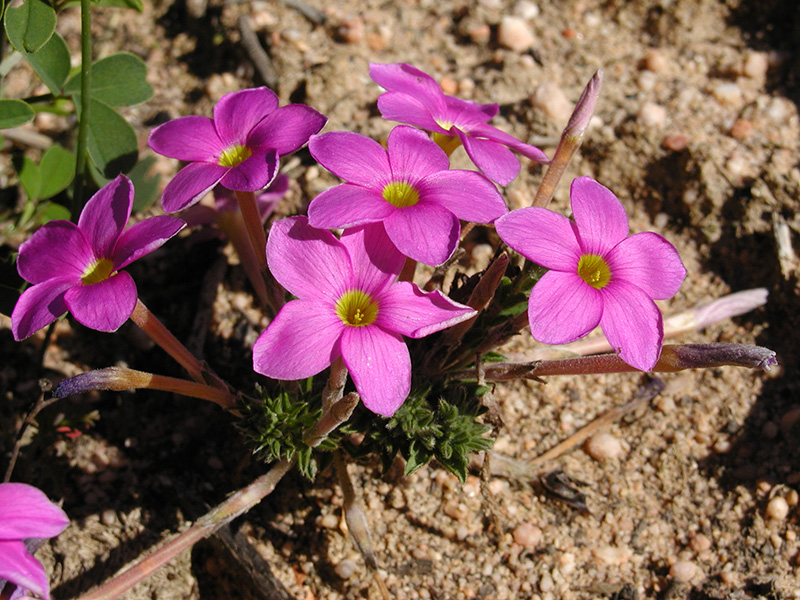
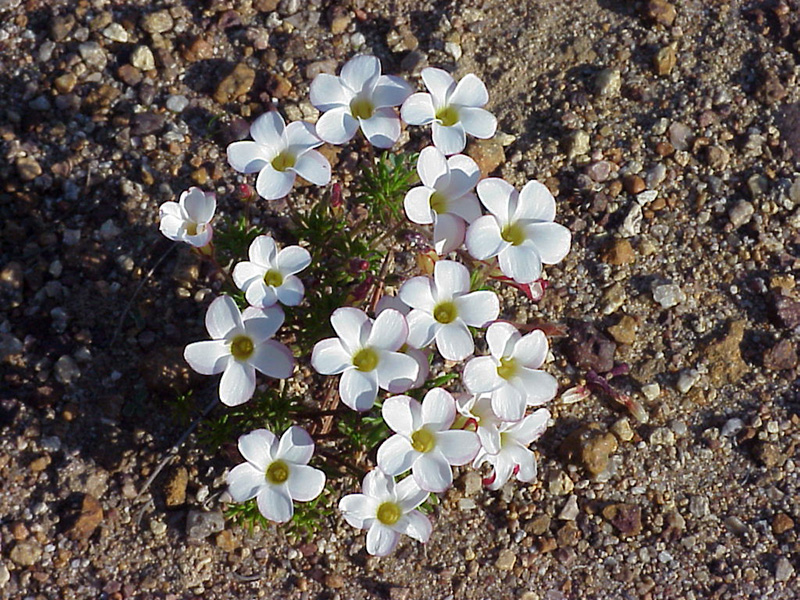
Over millions of years, these two Cape Oxalis species, Oxalis hirta (left) and Oxalis tenuifolia (right), have developed symbiotic relationships with bacteria from the genus Bacillus, to such an extent that their seeds inherit the bacteria from the mother plant.︱Photos by Prof Léanne Dreyer
Unique sexual reproduction system prevents inbreeding
Oxalis is one of only six genera in the world that display a unique sexual reproduction system called "tristyly", meaning a typical Oxalis species has three types of flowers (known as "floral morphs") named after the length of the style – short, medium, or long. The stamens (pollen-producing reproductive organs) are carried at separate levels, such that each flower has reproductive structures at three distinct levels. The different morphs are more or less evenly distributed across populations. Seed formation will only take place once pollination has occurred between styles of the same height.
According to Dreyer, this is a strategy employed to prevent inbreeding in a population. But in a population already under stress caused by habitat loss and a changing climate, the equal ratio of morph types normally present in a population could be disturbed. If one or more morphs are lost from a population, the population will experience reduced or no seed set, which, if pushed to the extreme, could lead to the extinction of the species.
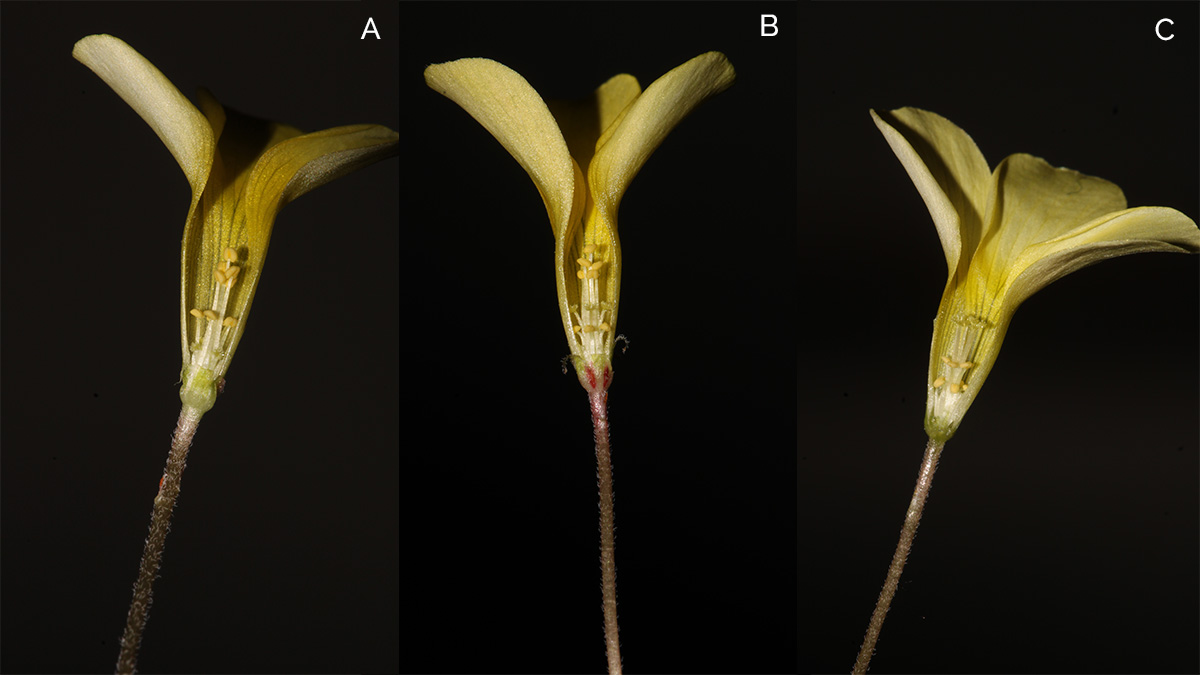
Floral morphs of Oxalis fragilis (a = short, b= mid, c= long)︱Photos by Brian du Preez
From seedling to bulb
According to Dreyer, researchers are only now starting to unravel the extremely rapid mode of bulb formation in Oxalis.
All plants have apical meristems — regions at or near stem and root tips where active cell division and growth take place. It is this capability of cells in the apical meristem that enables plants to constantly keep growing. In the case of stemless Oxalis species, the apical meristem is situated just above ground level, and surrounded by the petioles (stalks) of the leaves. In recalcitrant species, the apical meristems are "contracted into" the mature radicle, mainly through the action of the central portion of the root known as the "stele".
At the end of the growing season, the stele starts coiling, the corkscrew-like action pulling the apical meristem deep into the root.
This downward descent of the apical meristem is thought to be further helped along by an elongation of the petioles. The apical meristem then transforms into the first bulb, which stays dormant below ground during summer.
“This is how Oxalis succeeds in forming a bulb directly after growing from seed in the first season,” Dreyer explains. At the onset of the next growing season, a rhizome (in this case, a vertical underground plant stem) will emerge from the bulb and build the above-ground Oxalis plant body during the following wet winter months.
According to Dreyer, some of these bulbs are buried as deep as 60 cm underground. This makes them notoriously hard to find, even for baboons.
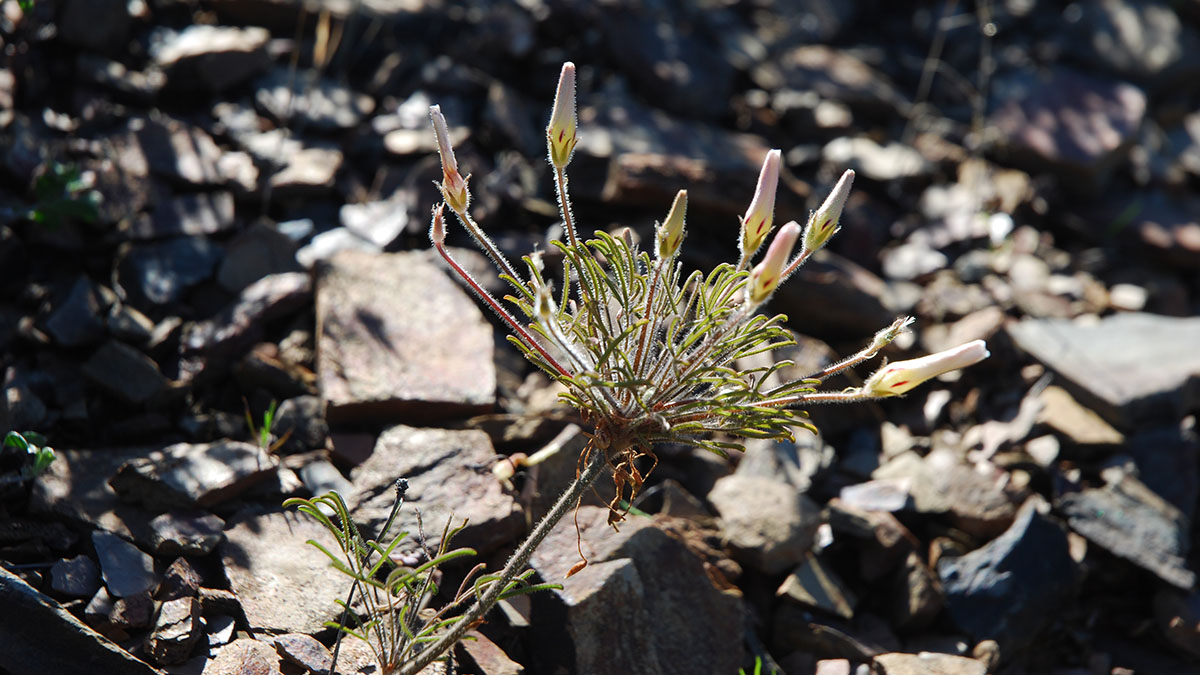
Oxalis deserticola in the wild | Photo by Michael Kuhlman
Locating rare species
Because it is so difficult to find these rare and elusive species, Dreyer relies on farmers and amateur botanists to alert her when an area receives good rainfall.
At the end of June this year, she and her team visited Nieuwoudtville, where the Cape fynbos biome meets the Succulent Karoo, after the region experienced one of the best rainy seasons in decades.
The team aimed to fill species gaps and preserve as much genetic diversity as possible in the Oxalis research collection at the SU Botanical Garden. Dreyer also revisited some of the locations where Salter identified certain rare species in the 1940s, most of which have not been observed since.
Over the years, her research group has documented a record number of more than 20 new species. Almost half of them were discovered in the Richtersveld, following good rains in 2006 and 2007.
Sometimes these little beauties hide in plain sight. In 2021, postgraduate student Frikkie Becker stumbled across a rare species, Oxalis minuta, popping up on the lawn in front of the GG Cillié Building on SU’s main campus.
This species was known to occur in both the Jan Marais and Duthie Reserves in Stellenbosch, but in extremely small, dwindling populations. With the help of Kirkwood, this valuable newfound population was moved into cultivation to form part of the Oxalis living collection.
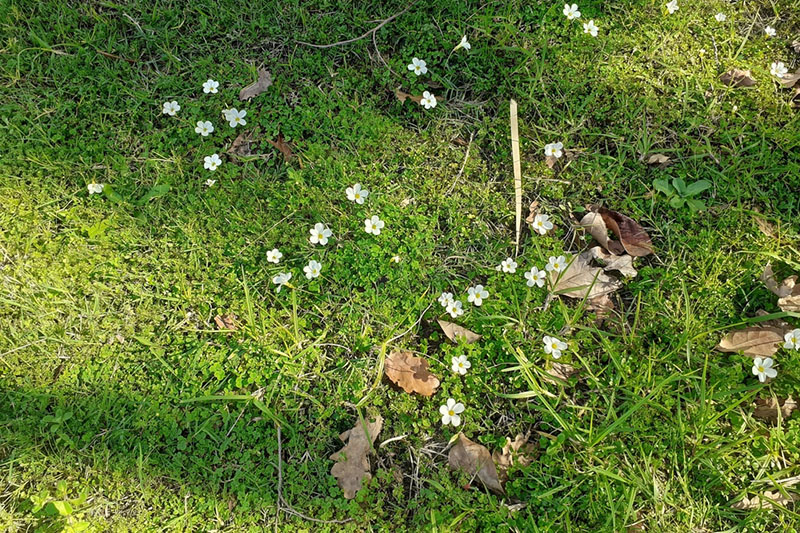
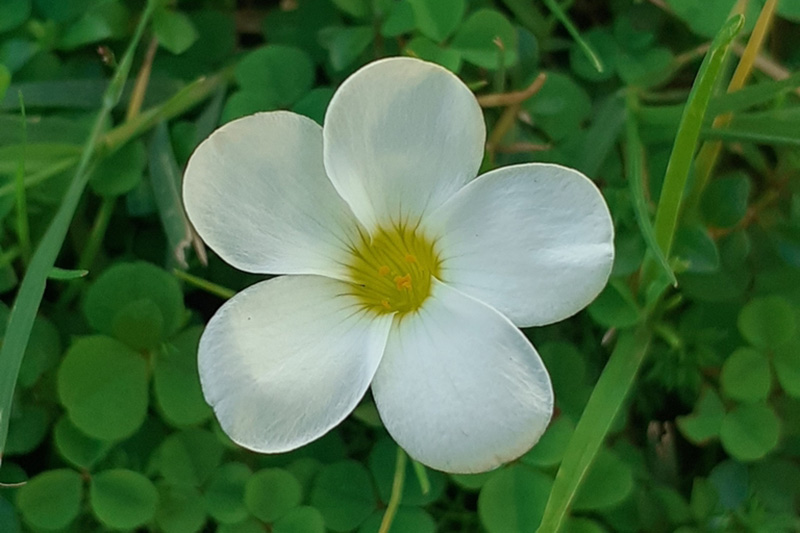
Oxalis minuta, found growing on the lawn in front of the GG Cillié Building on SU’s main campus︱Photos by Frikkie Becker
Subject(s) to change
Human activities, especially the fragmentation and destruction of natural habitats, are putting the survival of Oxalis at risk. When climate change is added to the mix, the picture becomes even bleaker.
An increase in temperature of 0,5 to 1,0 °C and a 25% decrease in annual rainfall are predicted for the Cape Floral Region over the next 50 years. This will likely have a dramatic impact on especially the rare Oxalis species.
Oxalis hygrophila, for example, is known from a single locality on a moist, natural seepage band in the Pakhuis Pass in the northern Cederberg. It was identified for the first time in 1944. “When we visited the site in 2001, flowers were present in November. During 2005 and 2006, we visited on several occasions from October to November, but no plants were found, and there was no evidence of water seepage down this slope,” Dreyer says.
Moreover, many of the rare Oxalis species have very specific habitat requirements, which confine them to small, isolated populations within specific localities. Given their dependence on suitable habitats to increase their population size, they are extremely threatened by future habitat loss.
Oxalis fragilis, for example, currently exists in only one known natural population in a highly fragmented landscape. Before its rediscovery in 2018, the species was last seen in 1936, despite repeated searches for it over the preceding 20 years. It was believed to have gone extinct in the wild.
“We were shocked to learn that the site where this population was rediscovered had been approved for dam construction. The population that was likely isolated for more than 80 years is now conserved largely in situ as part of SU Botanical Garden's living collection,” says Dreyer.
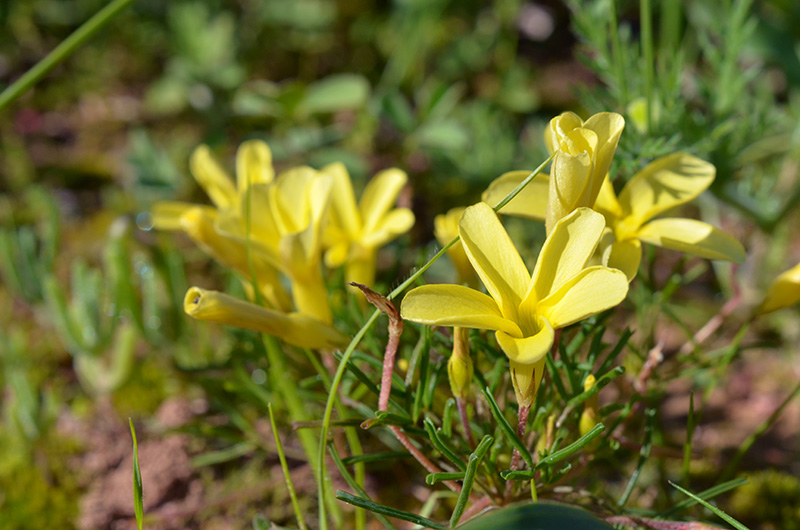
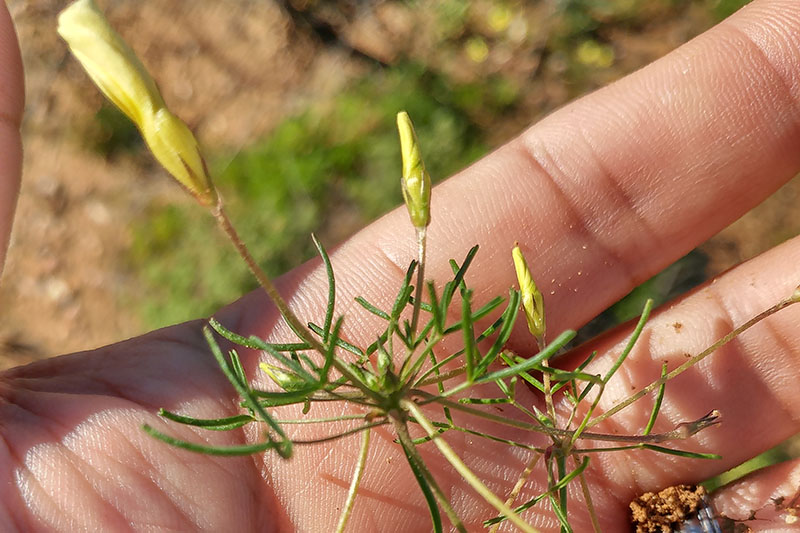
A population of critically endangered Oxalis fragilis was moved from the wild to the Oxalis research collection in the SU Botanical Garden before the area was repurposed for the construction of a dam.︱Photos by Prof Léanne Dreyer
Looking forward
Dreyer’s lifetime of research is thriving in the form of the Oxalis research collection in the SU Botanical Garden, and work on the Oxalis field guide has reached a point where the co-authors are ready to approach a publisher.
Dreyer describes herself as an intuitive scientist, intrigued by the many forms of this little plant’s seeds, flowers, and bulbs.
“In trying to understand Oxalis, one cannot rely on statistics and data alone,” she says. “I often first have an intuitive understanding of what may be happening, and then only do we set up experiments in the laboratory to test these ideas. Sometimes I’m right. Most of the time, though, I’m completely gobsmacked by our discoveries.
“When I die, they will write on my tombstone: She studied Oxalis — a genus in a hurry!", she quips with a hearty laugh.
Better known as "sorrel" in English or "suring" in Afrikaans, Oxalis is native to South America and Southern Africa, with about 800 different species in the genus.
The Southern African Oxalis species are all geophytes with true underground bulbs, while their South American counterparts are often shrubs and even trees. The genus was first described by Swedish botanist Carl Linnaeus in 1753.
The botanical name Oxalis is derived from the Greek word oxus, meaning "acid" or "acidic". Given its sour tang, it can be used as a substitute for lemon in a waterblommetjie stew. Oxalis is also rich in vitamin C and can be used to treat scurvy, fever, mouth sores, nausea, and a sore throat.
Did you know?
- About 30% of all Southern African Oxalis species are rare or endangered.
- Most species are limited by their highly specific habitat requirements and are particularly vulnerable to variations in rainfall patterns.
- Within Southern Africa, Oxalis represents the seventh largest genus in the Cape Floral Region.
- After Drosera, Oxalis is the second genus for which directionality of dispersal can be inferred from South America to Africa.

The research initiatives reported on above are geared towards addressing the United Nations’ Sustainable Development Goals numbers 13 and 15 and goal numbers 5 and 7 of the African Union’s Agenda 2063.